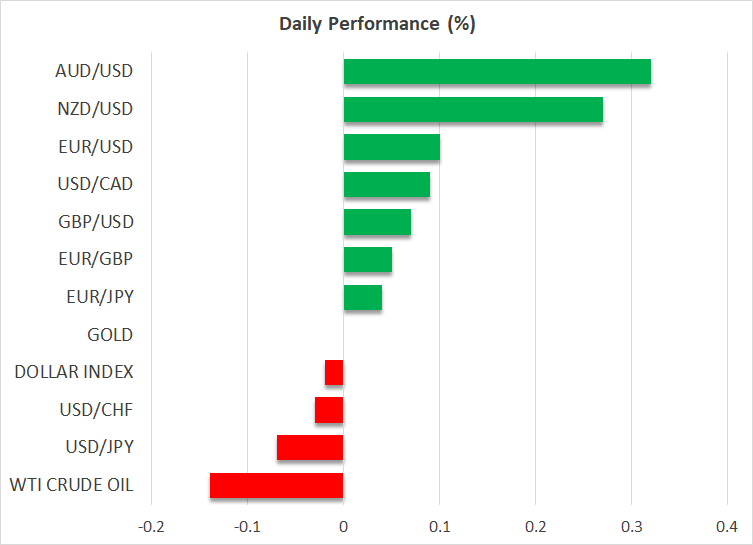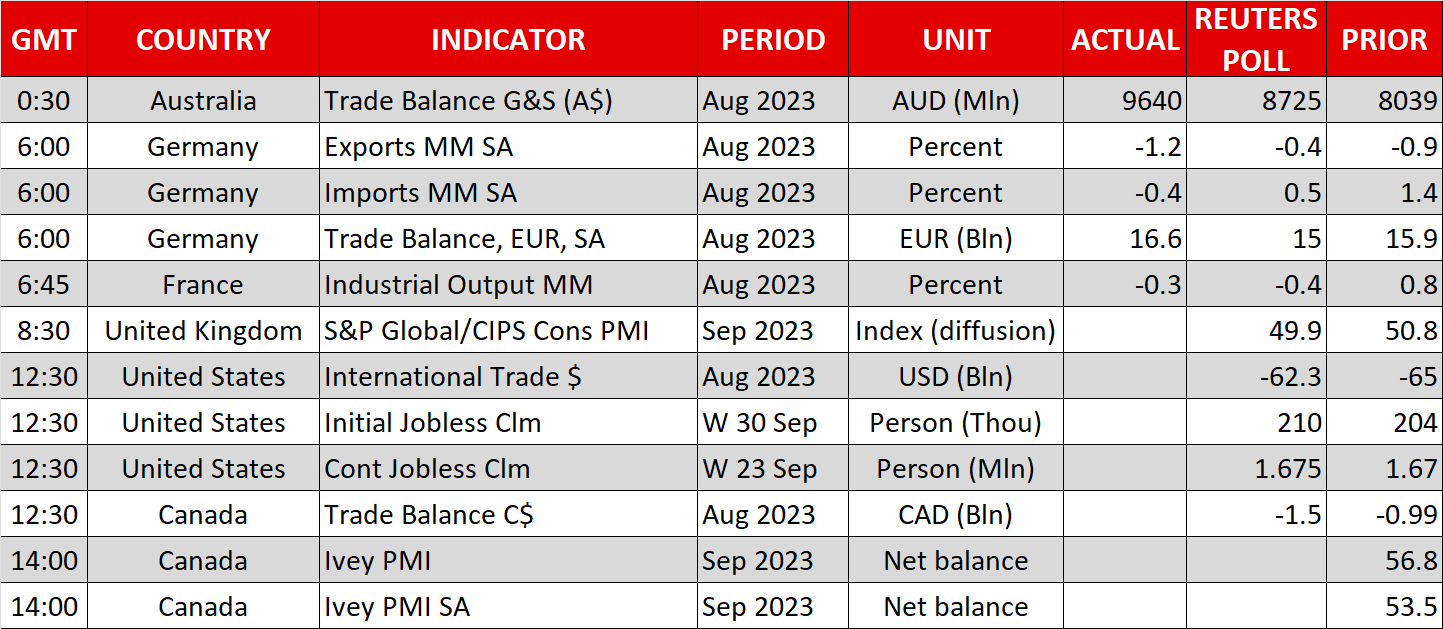Market Comment – Dollar pulls back after weak private payrolls report
ADP reveals lower-than-expected increase in private payrolls
Dollar retreats as investors lower their implied Fed rate path
Yen gains, but long-lasting recovery remains questionable
Wall Street bounces off lows, oil tumbles
 Dollar slips as ADP report disappoints
Dollar slips as ADP report disappointsThe US dollar pulled back on Wednesday and continued trading on the back foot today, after the ADP National Employment Report revealed that US private payrolls increased by far less than expected in September, suggesting that the labor market is indeed feeling the heat of higher interest rates.
Traders rushed to lower their implied Fed rate path and they are now assigning only a 40% probability for another rate hike by December, while they expect interest rates to end 2024 at 4.6%, notably below the Fed’s projection of 5.1%.
Having said that though, other data continued to point to a US economy that continues to perform well. The ISM non-manufacturing PMI declined as new orders fell to a nine-month low, but the pace remained consistent with expectations of solid growth in Q3. On top of that, the survey showed that services inflation remained elevated, while employment slowed only gradually, suggesting that it is too early for Fed officials to abandon the ‘higher for longer’ mentality.
Following the weak ADP print, investors will now be eager to see whether nonfarm payrolls will also miss their forecast on Friday, although history has shown that the former is far from a reliable predictor of the latter. Nonfarm payrolls are expected to have slowed to 163k in September from 187k, but the unemployment rate is expected to have ticked down and wage growth to have remained elevated. Such a report could revive trust in the Fed’s ‘higher for longer’ view and perhaps allow Treasury yields and the US dollar to rebound and extend their uptrends.
Yen gains again, awaits official US jobs dataThe Japanese yen ended Wednesday on the back foot, despite Tuesday’s sharp rally that stoked speculation of intervention. That said, the Japanese currency recovered again today during Asian trading, with ‘Gotobi Day’ being cited as a reason this time. ‘Gotobi’ refers to the practice of payments in Japan being made every fifth day. Given that these are the days many Japanese companies are typically settling accounts and payments, they can lead to increased activity in the banking and financial sectors.
Attention for dollar/yen traders will now start shifting towards tomorrow’s US jobs data, where a decent report could result in some recovery. The big question though is whether this recovery will take the pair back above 150, and whether such a breach will trigger a second round of intervention.
Nonetheless, even in the case of intervention, the bigger picture is unlikely to be altered much. As long as the BoJ keeps Japanese government bond (JGB) yields capped and the Fed remains willing to keep interest rates higher for longer, dollar/yen may be destined for a rebound.
Wall Street rebounds, oil falls on weak demand for gasolineWall Street took a breather following the weaker-than-expected ADP report and the lowering of the market’s implied rate path, with the more rate-sensitive Nasdaq gaining the most. That said, with the earnings season kicking off and Friday’s nonfarm payrolls still pending, it seems unwise to assume that Wall Street hit a bottom.
Elsewhere, oil prices tumbled yesterday as the Energy Information Administration (EIA) reported that finished motor gasoline supplies, a proxy for demand, fell to the lowest level since the beginning of the year last week.
Although OPEC+ members maintained output cuts to keep supply tight, it seems that demand concerns are starting to be reflected in prices, and with China and Eurozone, the world’s two largest oil consumers behind the US, facing economic challenges, those concerns may continue to grow.

Related Assets
Latest News
Disclaimer: The XM Group entities provide execution-only service and access to our Online Trading Facility, permitting a person to view and/or use the content available on or via the website, is not intended to change or expand on this, nor does it change or expand on this. Such access and use are always subject to: (i) Terms and Conditions; (ii) Risk Warnings; and (iii) Full Disclaimer. Such content is therefore provided as no more than general information. Particularly, please be aware that the contents of our Online Trading Facility are neither a solicitation, nor an offer to enter any transactions on the financial markets. Trading on any financial market involves a significant level of risk to your capital.
All material published on our Online Trading Facility is intended for educational/informational purposes only, and does not contain – nor should it be considered as containing – financial, investment tax or trading advice and recommendations; or a record of our trading prices; or an offer of, or solicitation for, a transaction in any financial instruments; or unsolicited financial promotions to you.
Any third-party content, as well as content prepared by XM, such as: opinions, news, research, analyses, prices and other information or links to third-party sites contained on this website are provided on an “as-is” basis, as general market commentary, and do not constitute investment advice. To the extent that any content is construed as investment research, you must note and accept that the content was not intended to and has not been prepared in accordance with legal requirements designed to promote the independence of investment research and as such, it would be considered as marketing communication under the relevant laws and regulations. Please ensure that you have read and understood our Notification on Non-Independent Investment. Research and Risk Warning concerning the foregoing information, which can be accessed here.